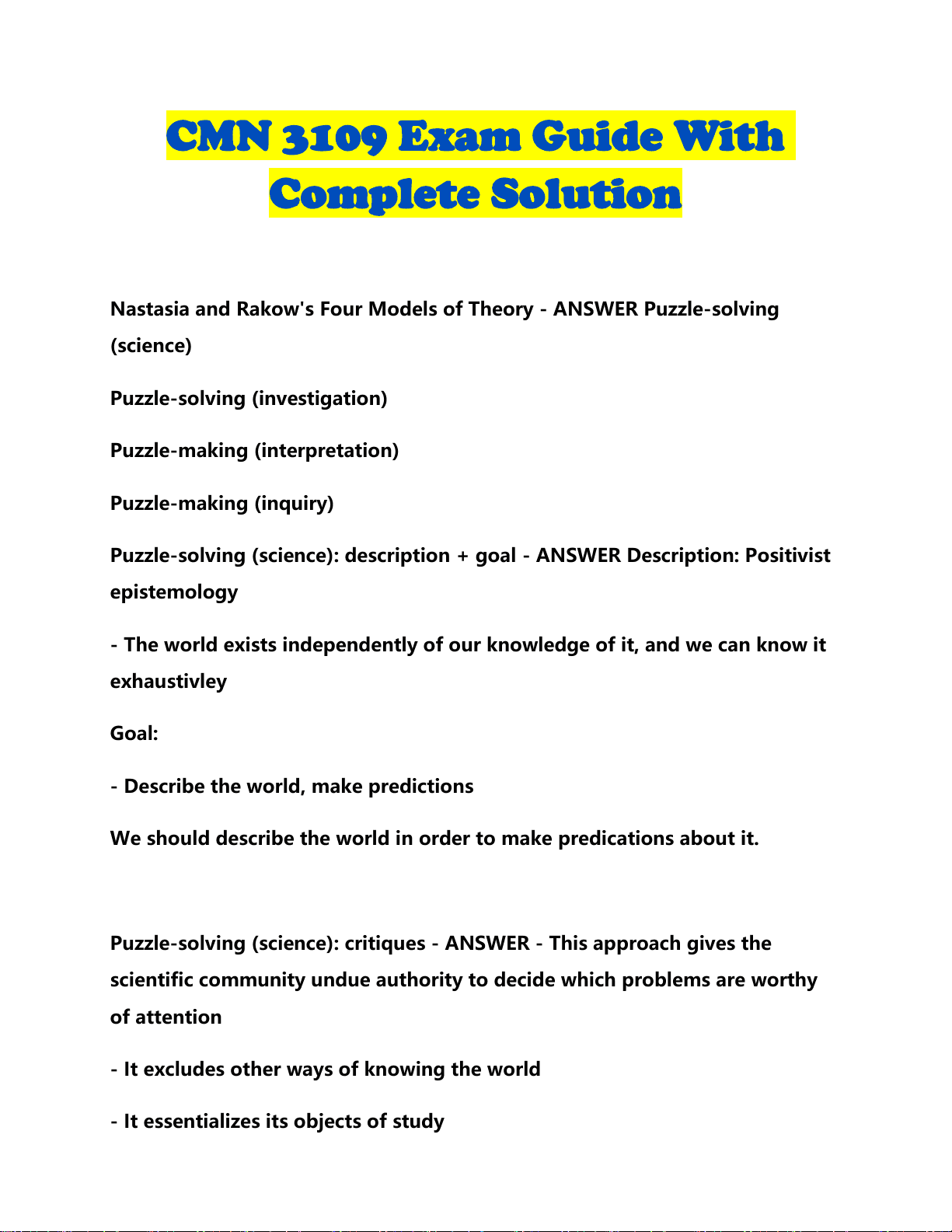
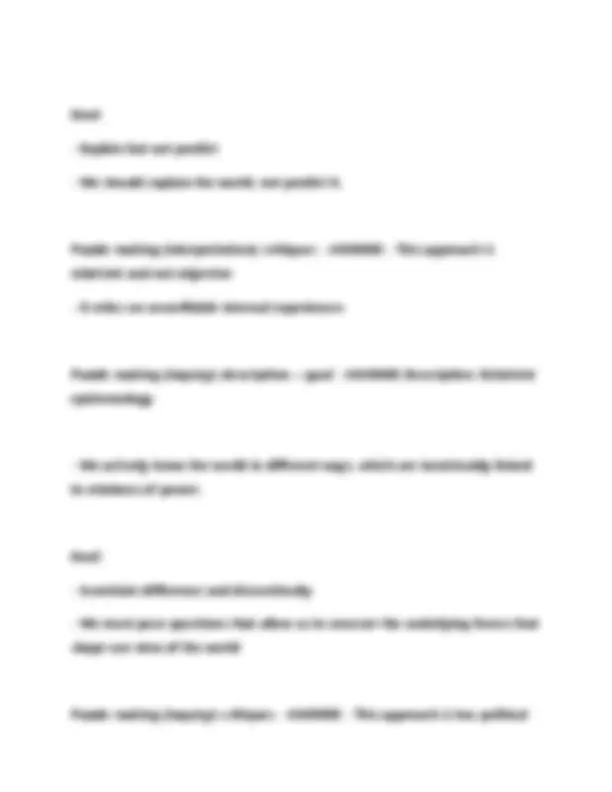
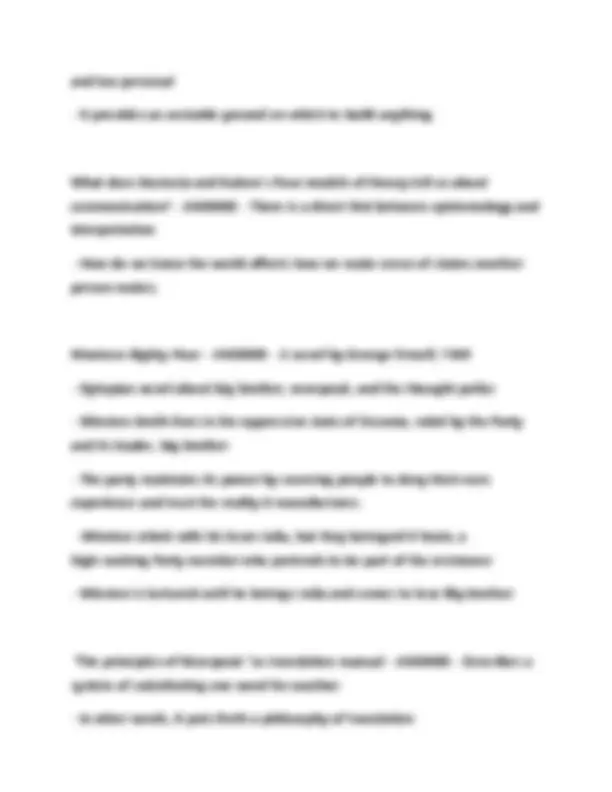
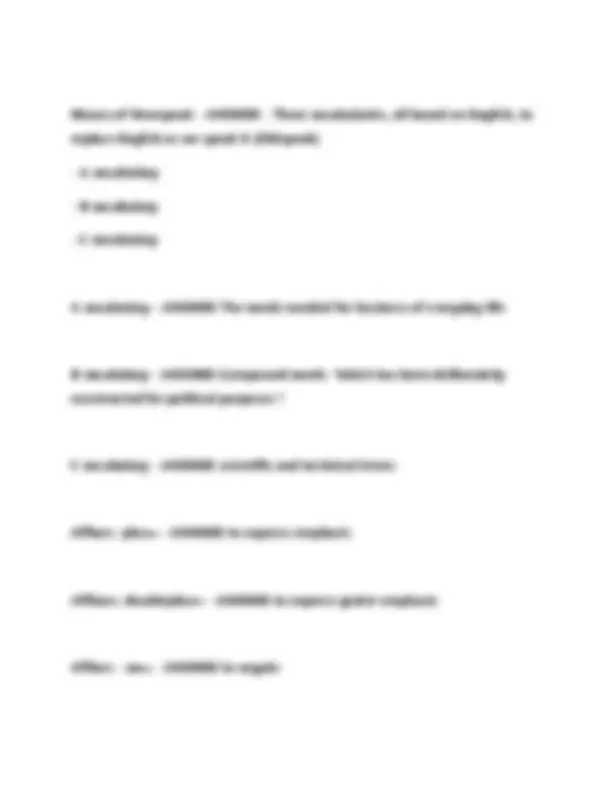
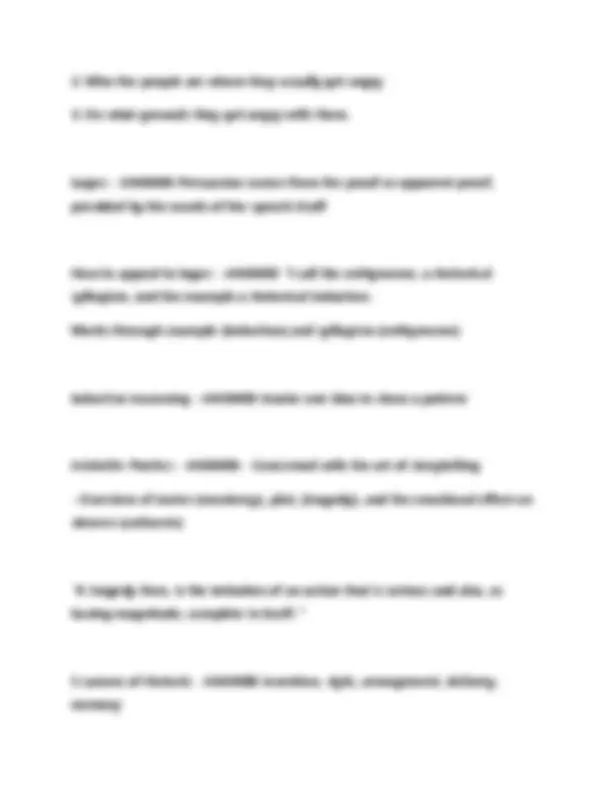
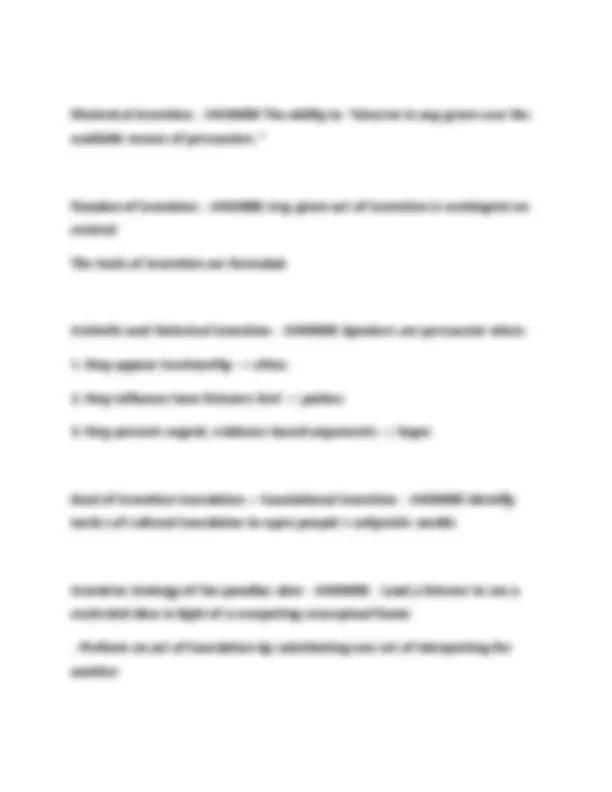
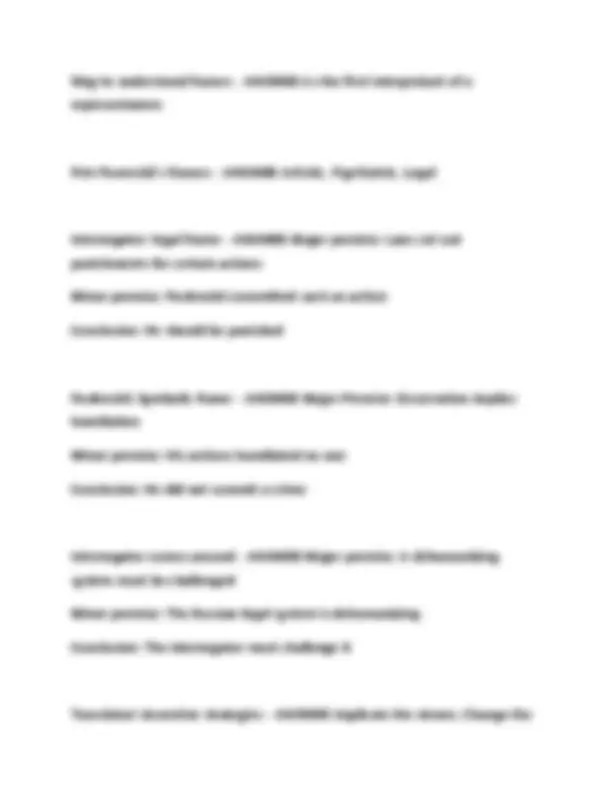

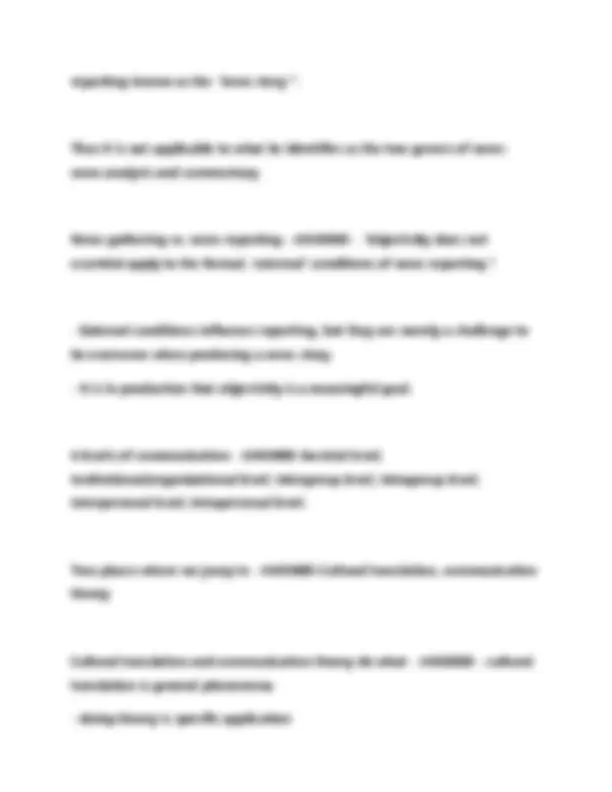



Study with the several resources on Docsity

Earn points by helping other students or get them with a premium plan


Prepare for your exams
Study with the several resources on Docsity

Earn points to download
Earn points by helping other students or get them with a premium plan
Community
Ask the community for help and clear up your study doubts
Discover the best universities in your country according to Docsity users
Free resources
Download our free guides on studying techniques, anxiety management strategies, and thesis advice from Docsity tutors
A comprehensive overview of nastasia and rakow's four models of communication theory: puzzle-solving (science and investigation), and puzzle-making (interpretation and inquiry). it delves into the epistemological underpinnings of each model, critiques their strengths and weaknesses, and explores their implications for understanding communication. the document also examines relevant concepts such as newspeak from orwell's nineteen eighty-four, solipsism, gaslighting, and aristotle's rhetoric, enhancing the understanding of communication's complexities.
Typology: Exams
1 / 15

This page cannot be seen from the preview
Don't miss anything!










Nastasia and Rakow's Four Models of Theory - ANSWER Puzzle-solving (science)
Puzzle-solving (investigation)
Puzzle-making (interpretation)
Puzzle-making (inquiry)
Puzzle-solving (science): description + goal - ANSWER Description: Positivist epistemology
Goal:
We should describe the world in order to make predications about it.
Puzzle-solving (science): critiques - ANSWER - This approach gives the scientific community undue authority to decide which problems are worthy of attention
Puzzle-solving (investigation): description + goal - ANSWER Description: Neo-positivist epistemology
The world exists independently of our knowledge of it, but we cannot know it exhaustively
Goal:
Puzzle-solving (investigation): critiques - ANSWER - This approach describes surface phenomena but not the forces that underlie them.
Puzzle-making (interpretation): description + goal - ANSWER Description: Constructivist epistemology
and too personal
What does Nastasia and Rakow's Four models of theory tell us about communication? - ANSWER - There is a direct link between epistemology and interpretation
Nineteen Eighty-Four - ANSWER - A novel by George Orwell, 1949
-Winston rebels with his lover Julia, but they betrayed O'brain, a high-ranking Party member who pretends to be part of the resistance
"The principles of Newspeak" as translation manual - ANSWER - Describes a system of substituting one word for another
Means of Newspeak - ANSWER - Three vocabularies, all based on English, to replace English as we speak it (Oldspeak)
A vocabulary - ANSWER The words needed for business of everyday life
B vocabulary - ANSWER Compound words "which has been deliberately constructed for political purposes".
C vocabulary - ANSWER scientific and technical terms
Affixes- plus— - ANSWER to express emphasis
Affiixes- doubleplus— - ANSWER to express grater emphasis
Affixes - un— - ANSWER to negate
Aristotle: Types of persuasion - ANSWER Political, Forensic, Ceremonial
Aristotle: Audience persuasion - ANSWER Persuade lawmakers, perusade judges, persuade peers
Temporality persuasion - ANSWER Future-oriented, past-oriented, and present-oriented
Ethos - ANSWER - Persuasion is achieved by the speaker's personal character when the speech is so spoken as it makes us think him credible
How to establish ethos - ANSWER good sense, good moral character, goodwill
Pathos - ANSWER Persuasion may come through the heareres, when the speech stirs their emotions
How to establish pathos - ANSWER The motions are all those feelings tha tso change mean as to affect their judgements, ans that are also attended by pain or plasure.
Logos - ANSWER Persuasion comes from the proof or apparent proof, provided by the words of the speech itself
How to appeal to logos - ANSWER "I call the enthymeme, a rhetorical syllogism, and the example a rhetorical induction.
Works through example (induction) and syllogism (enthymeme)
inductive reasoning - ANSWER Invoke one idea to show a pattern
Aristotle: Poetics - ANSWER - Concerned with the art of storytelling
"A tragedy then, is the imitation of an action that is serious and also, as having magnitude, complete in itself."
5 canons of rhetoric - ANSWER invention, style, arrangement, delivery, memory
Way to understand frames - ANSWER As the first interpretant of a representamen
Petr Pavenskii's frames - ANSWER Artistic, Psychiatric, Legal
Interrogator: legal frame - ANSWER Major premise: Laws set out punishments for certain actions
Minor premise: Pavlenskii committed such an action
Conclusion: He should be punished
Pavlenskii: Symbolic frame - ANSWER Major Premise: Desecration implies humiliation
Minor premise: His actions humiliated no one
Conclusion: He did not commit a crime
Interrogator comes around - ANSWER Major premise: A dehumanizing system must be challenged
Minor premise: The Russian legal system is dehumanizing
Conclusion: The interrogator must challenge it
Translaton'sinventive strategies - ANSWER Implicate the viewer, Change the
first interpretant (the frame)
Our tools of invention— Aristotle - ANSWER Appeals to pathos, ethos, logos
Within logos: enthymeme and example
Our tools on invention — Pavlenskii - ANSWER Implicate viewer
Change frame (first interpretant)
What is objectivity? - ANSWER A central contradiction
What is objectivity? Philosophical answer - ANSWER - the capacity to describe the world as it is, rather than how we perceive it to be
Why does objectivity matter? - ANSWER We need to know about the world— and we need to be able to trust what we know— in order to act on it. But— we can't know the world merely as it is. We have no choice but to rely on our senses, which can deceive us.
Structure information in appropriate sequences - ANSWER Inverted pyramid (first main information, then increasingly specific details) allows journalists to claim they're only reporting the facts
Formal attributes of newspaper - ANSWER Put "objective" "hard news" stories on the front page
Put in opinion pieces of the op-ed page (opposite to the editorial)
Interorganizational relationships - ANSWER 1. "Most individuals, as news sources, have an axe to grind"
Reporting vs. analysis - ANSWER "Objectivity can only be applied to straight news reporting."
Analysis is a valid journalistic approach but by definition it is not objective
Genre - ANSWER "Objectivity can only be applied to that genre of new
reporitng known as the "news story"'.
Thus it is not applicable to what he identifies as the two genres of news: news analysis and commentary
News gathering vs. news reporting - ANSWER - "objectivity does not essential apply to the formal, 'external' conditions of news reporting".
6 levels of communication - ANSWER Societal level, Institutional/organizational level, Intergroup level, Intragroup level, Interpersonal level, Intrapersonal level.
Two places where we jump in - ANSWER Cultural translation, communication theory
Cultural translation and communication theory do what - ANSWER - cultural translation is general phenomena